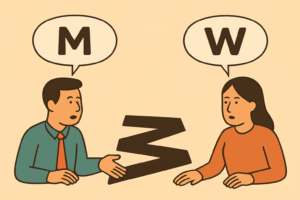The leadership team had just finished weeks of strategic planning. The vision document looked solid, the roadmap was clear, and everyone around the table was nodding in agreement. When someone suggested adding “committed” to their core values, heads bobbed enthusiastically.
Three months later, half their initiatives had stalled, two key team members had left, and the board was demanding answers. Team members were frustrated, pointing fingers, and leadership was baffled. How had everything gone sideways when they’d all agreed on the plan?
The problem wasn’t the strategy. It was that “committed” meant something completely different to each person in that room, a miscommunication that could have been prevented in five minutes with the right questions.
The Million-Dollar Misunderstanding
Communication expert Caitlin Walker encountered this scenario while working with a leadership team on their company vision. When they reached values and someone suggested “committed,” everyone enthusiastically agreed.
Then Walker asked one simple question: “When you’re committed, that’s like what, for you?”
The first executive explained that commitment meant sticking exactly to agreements. “Whatever we say we’re gonna do, we stick exactly to what it is. Everyone can expect everyone else to do what’s in their expectations.”
Before he’d finished speaking, another leader interrupted: “Absolutely not. I’m not agreeing to that. For me, if I’m committed, it means I stand by my values. No matter what we agreed, I will adjust my behavior to keep aligned with my values and hold the company to our values, not what our agreements are.”
Same word. Opposite meanings. And they were about to make strategic decisions based on these conflicting assumptions.
Why This Happens More Than You Think
This isn’t an isolated incident. It happens in organizations every day, often with devastating consequences. The problem isn’t that people are bad communicators. It’s that we assume shared language means shared understanding.
Consider how often these scenarios play out in your organization:
- A team says they need “more resources” but half mean budget and the rest mean better tools
- Leadership calls for “innovation” but some think incremental improvement while others envision transformational disruption
- Everyone agrees the customer experience should be “seamless” but definitions range from “fewer clicks” to “emotional connection” to “no wait times”
Each misalignment costs time, money, and trust. Research shows that poor communication costs businesses an average of $12,506 per employee annually. Worst of all, these costs are invisible until they compound into major failures.
What Is Clean Language?
Walker’s approach comes from clean language, a questioning technique developed by David Grove, who was interested in a fundamental challenge: How do you get authentic information from people without accidentally shaping their responses with your own assumptions?
Recent research confirms this matters. A 2023 study in Frontiers in Human Neuroscience found that subtle differences in phrasing affect decision-making and perception, showing that question framing significantly influences how people interpret information and respond.
Grove discovered you could ask powerful questions using a person’s exact words, without adding your interpretations or suggestions. Questions like:
- “What kind of [their word]?”
- “What would you like to have happen?”
- “[Their metaphor] is like what?”
When Walker first encountered Grove’s work, her reaction was immediate: “That tool is simple enough that I could teach it to school children or to the board members of an international business.” She’d been searching for something both simple and powerful enough to create real change, and here it was.
Over 25 years, she has adapted clean language specifically for business contexts, stripping away therapeutic elements while keeping the core power of the technique. Studies on active listening confirm that when people feel truly heard without judgment, they share more accurate and complete information.
The principle is deceptively simple: Before you assume you understand what someone means, ask them using their exact words.
How Five Minutes Would Have Prevented the Crisis
If that leadership team had spent just five minutes asking “What kind of committed?” to each person, they would have discovered their fundamental misalignment immediately.
One saw commitment as rigid adherence to agreements, while the other saw it as flexible alignment with values that might require changing agreements.
Walker notes that just “one or two clean questions” can reveal these critical differences and “stop you arguing, you know, three months down the line when you realize that you were talking about different things.”
Without those five minutes of clarification, this team likely:
- Made strategic decisions based on different assumptions about what “committed” meant
- Found themselves in conflict when those assumptions collided
- Wasted time and energy on disagreements that stemmed from misalignment, not from actual differences in goals
With that clarity, they could have either:
- Asked one another, when we are committed, what would you see & hear that would let us know there was commitment?
- Is there another word that encapsulates what’s important to each of us?
- Explicitly defined what “committed” meant in their context
- Acknowledged they had different working styles that complemented each other
Why Two Questions Are Enough
These questions create space for people to explain their thinking without imposing your interpretation. As Walker explains: “It doesn’t take very much. You can just ask one or two clean questions to turn 2D language into 3D language so you know what this person means rather than just assuming.”
In business settings, Walker recommends asking only one or two questions before moving on. More than that needs a more formal coaching contract. One or two Clean questions per day keep assumptions at bay.
Start Here
The next time someone uses a vague term in a meeting, pause and ask:
- “What kind of [their word] is that?”
Just that one question, using their exact words, will often reveal assumptions you didn’t know existed.
Expect some initial surprise; people aren’t used to being asked exactly what they mean. But that brief discomfort is nothing compared to the cost of three months executing on misaligned assumptions.
Because here’s the truth: How can you build something together if you’re not even talking about the same thing?
Next in this series: How two leaders described the same “stuck” project using completely different metaphors and why their solutions would never have worked for each other’s versions of the problem.
About the Expert
Caitlin Walker (PhD) has spent 25 years adapting clean language for business contexts. She works with leadership teams, organizations, and groups worldwide to improve communication, reduce conflict, and build collaborative cultures.
Want to learn more? Join Caitlin Walker and Wayne Hetherington for the free webinar “Clean Questions – The Antidote to Micro-Aggressions” on October 20, 12:00–1:00 PM EST. This is the first webinar in the “More Synergy. Less Misery.” series. [Register here →]
Caitlin will also bring her expertise to Toronto in February 2026 for an exclusive leadership intensive. Follow us for updates.




